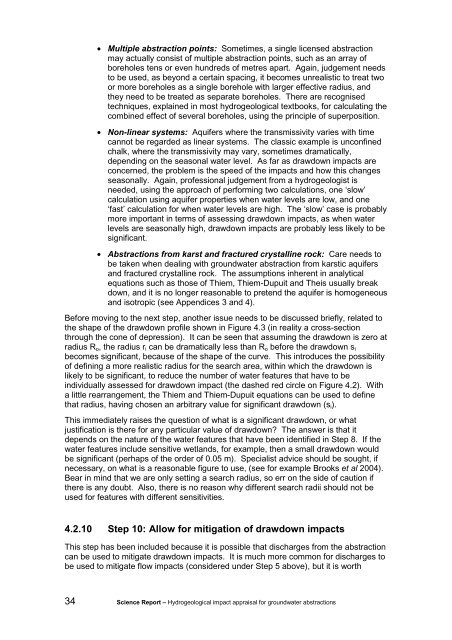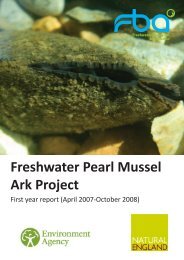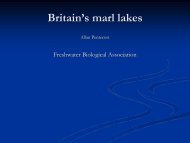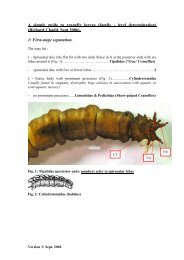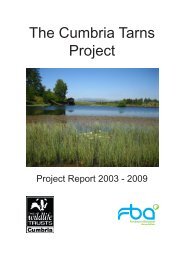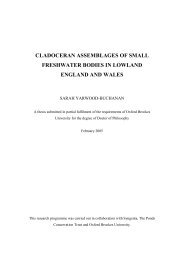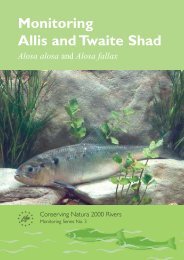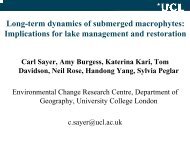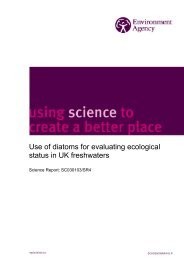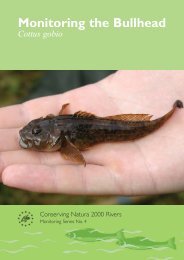Groundwater HIA post edit - FreshwaterLife
Groundwater HIA post edit - FreshwaterLife
Groundwater HIA post edit - FreshwaterLife
You also want an ePaper? Increase the reach of your titles
YUMPU automatically turns print PDFs into web optimized ePapers that Google loves.
• Multiple abstraction points: Sometimes, a single licensed abstraction<br />
may actually consist of multiple abstraction points, such as an array of<br />
boreholes tens or even hundreds of metres apart. Again, judgement needs<br />
to be used, as beyond a certain spacing, it becomes unrealistic to treat two<br />
or more boreholes as a single borehole with larger effective radius, and<br />
they need to be treated as separate boreholes. There are recognised<br />
techniques, explained in most hydrogeological textbooks, for calculating the<br />
combined effect of several boreholes, using the principle of superposition.<br />
• Non-linear systems: Aquifers where the transmissivity varies with time<br />
cannot be regarded as linear systems. The classic example is unconfined<br />
chalk, where the transmissivity may vary, sometimes dramatically,<br />
depending on the seasonal water level. As far as drawdown impacts are<br />
concerned, the problem is the speed of the impacts and how this changes<br />
seasonally. Again, professional judgement from a hydrogeologist is<br />
needed, using the approach of performing two calculations, one ‘slow’<br />
calculation using aquifer properties when water levels are low, and one<br />
‘fast’ calculation for when water levels are high. The ‘slow’ case is probably<br />
more important in terms of assessing drawdown impacts, as when water<br />
levels are seasonally high, drawdown impacts are probably less likely to be<br />
significant.<br />
• Abstractions from karst and fractured crystalline rock: Care needs to<br />
be taken when dealing with groundwater abstraction from karstic aquifers<br />
and fractured crystalline rock. The assumptions inherent in analytical<br />
equations such as those of Thiem, Thiem-Dupuit and Theis usually break<br />
down, and it is no longer reasonable to pretend the aquifer is homogeneous<br />
and isotropic (see Appendices 3 and 4).<br />
Before moving to the next step, another issue needs to be discussed briefly, related to<br />
the shape of the drawdown profile shown in Figure 4.3 (in reality a cross-section<br />
through the cone of depression). It can be seen that assuming the drawdown is zero at<br />
radius Ro, the radius ri can be dramatically less than Ro before the drawdown si<br />
becomes significant, because of the shape of the curve. This introduces the possibility<br />
of defining a more realistic radius for the search area, within which the drawdown is<br />
likely to be significant, to reduce the number of water features that have to be<br />
individually assessed for drawdown impact (the dashed red circle on Figure 4.2). With<br />
a little rearrangement, the Thiem and Thiem-Dupuit equations can be used to define<br />
that radius, having chosen an arbitrary value for significant drawdown (si).<br />
This immediately raises the question of what is a significant drawdown, or what<br />
justification is there for any particular value of drawdown? The answer is that it<br />
depends on the nature of the water features that have been identified in Step 8. If the<br />
water features include sensitive wetlands, for example, then a small drawdown would<br />
be significant (perhaps of the order of 0.05 m). Specialist advice should be sought, if<br />
necessary, on what is a reasonable figure to use, (see for example Brooks et al 2004).<br />
Bear in mind that we are only setting a search radius, so err on the side of caution if<br />
there is any doubt. Also, there is no reason why different search radii should not be<br />
used for features with different sensitivities.<br />
4.2.10 Step 10: Allow for mitigation of drawdown impacts<br />
This step has been included because it is possible that discharges from the abstraction<br />
can be used to mitigate drawdown impacts. It is much more common for discharges to<br />
be used to mitigate flow impacts (considered under Step 5 above), but it is worth<br />
34 Science Report – Hydrogeological impact appraisal for groundwater abstractions


